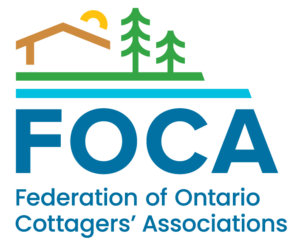
Many FOCA members are on lakes or rivers that form (or feed) the Trent Severn Waterway (TSW) and Rideau Canal.

Parks Canada manages Canadian national historic sites, including the Rideau Canal (202km long with 47 locks) and the Trent-Severn Waterway (386km long with 44 locks). Management of these two waterways was merged by Parks Canada in 2012.
According to Parks Canada, water on these waterways is managed on a system-wide basis to meet a broad range of stakeholder needs including recreation, municipal water supply, flood mitigation, hydro power generation and fisheries management. The complexities of these multiple and interconnected considerations dictate the need to monitor and manage water on a full time basis and continuously throughout the year, but it is particularly critical during the spring melt, or freshet.

June 2023 – CEWF has released two short videos to answer questions about high and low water levels through the Trent Watershed: how it works, where the water comes from and goes to, and who manages the levels through the seasons. Check them out at the links below.
The Coalition for Equitable Water Flow (CEWF) is a FOCA-member volunteer organization that was formed in 2006 to represent the interests of those who own residential shoreline property on 55 lakes that feed into the Trent Canal, the water levels of which are controlled by the Trent Severn Waterway (TSW).


You can track current, recent past, and projected water levels online:
- TSW water levels information from Parks Canada
- Rideau Canal water levels information from Parks Canada
The management plan is a key instrument for delivering Parks Canada’s mandate to protect and present nationally significant examples of Canada’s natural and cultural heritage, and to foster public understanding, appreciation and enjoyment in ways that ensure the ecological and commemorative integrity of these places for present and future generations. The introductory letter (PDF, 2 page) and a copy of the draft plan (PDF, 23 pages) provide further context. The Plan was up for review and public comment between April 4 and June 30, 2022 via an online platform and in-person sessions scheduled in May & June.
Related links:
- Rideau Corridor Landscape Strategy (2012)
- Report of the Panel on the Future of the TSW (2008)
- Save Our Rideau website (established in 2012 when operational changes to the Rideau Canal were made)
- Coalition for Equitable Water Flow (CEWF; volunteer organization since 2016, for property owners on the 35 reservoir and 20 flow-through lakes within the Haliburton Sector of the Trent River watershed)
- Voices for the Trent Severn Waterway (Facebook page; volunteer organization establish in 2008 by a group of stakeholders in the TSW)
About the Spring Freshet:
The annual spring melt of snowpack and ice into the watershed is referred to as the Spring Freshet.
According to Parks Canada, in preparation for the spring freshet, dam operations are undertaken in order to transition from winter settings and gradually fill reservoir lakes along the systems. Parks Canada staff continue to collect and analyze information regarding the year’s snow pack, the snow depth, and its water content.
Technical data analysis is conducted to assist the Agency with determining the expected inflows into the various waterbodies in the watershed, and informs their decision-making related to appropriate water levels in lakes.
Parks Canada also engage in such activities as clearing ice and snow from the dams in order to ensure that all equipment is in good working order and in a state of operational readiness on approach to the spring freshet.
While Parks Canada manages water levels year round, municipal partners and conservation authorities are responsible for flood preparedness and education, declaring public emergency, and provision for emergency situations.
According to Parks Canada, residents concerned about water level conditions are encouraged to follow up with these organizations in their area in advance to ensure they are well prepared. In addition, Parks Canada posts water management updates as the spring progresses online.

Please note: the following is archival material, and some links to third-party resources may no longer be active.
starting April 4, 2022 – Parks Canada is undertaking consultations on the draft Trent-Severn Waterway (TSW) Management Plan.
May 27, 2020 – COVID-19 impacts: Limited visitor access and basic services on TSW resumes June 1, 2020 (Parks Canada)
April 15, 2020 – COVID-19 impacts: On April 15, Parks Canada announced that the opening of all visitor services, including moorage and lockage along canals and waterways of the TSW and Rideau, is delayed until at least May 31. (The agency had originally expected to open the navigation season to the public by May 15.) More information and updates are here:
June 2016 – Federal government announces investments of $267.5 million for @25 infrastructure projects across the Trent-Severn Waterway National Historic Site.
June, 2014 – expanded hours of service on TSW announced
March 14, 2014 – Parks Canada announced $58 million in infrastructure investments for TSW (pdf; 4 pages)
July 2012 – FOCA Director and Severn River cottager Kay Soares attended the TSW Roundtable in Bobcaygeon.
June 2012 – FOCA’s Executive Director was quoted in an article about the June TSW meeting held in Peterborough.
Also, read this editorial, based upon the conversation with FOCA’s Executive Director, following the TSW meeting.
The TSW and Rideau management was merged by Parks Canada in 2012. Read about it, here…
For related topics, visit FOCA’s additional webpages:
